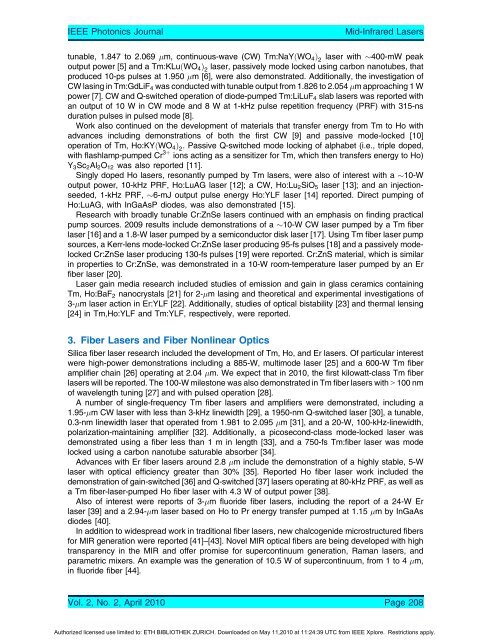Breakthroughs Breakthroughs - ETH - Ultrafast Laser Physics
Breakthroughs Breakthroughs - ETH - Ultrafast Laser Physics
Breakthroughs Breakthroughs - ETH - Ultrafast Laser Physics
You also want an ePaper? Increase the reach of your titles
YUMPU automatically turns print PDFs into web optimized ePapers that Google loves.
IEEE Photonics Journal Mid-Infrared <strong>Laser</strong>s<br />
tunable, 1.847 to 2.069 m, continuous-wave (CW) Tm:NaYðWO4Þ 2 laser with 400-mW peak<br />
output power [5] and a Tm:KLuðWO4Þ 2 laser, passively mode locked using carbon nanotubes, that<br />
produced 10-ps pulses at 1.950 m [6], were also demonstrated. Additionally, the investigation of<br />
CW lasing in Tm:GdLiF4 was conducted with tunable output from 1.826 to 2.054 m approaching 1 W<br />
power [7]. CW and Q-switched operation of diode-pumped Tm:LiLuF4 slab lasers was reported with<br />
an output of 10 W in CW mode and 8 W at 1-kHz pulse repetition frequency (PRF) with 315-ns<br />
duration pulses in pulsed mode [8].<br />
Work also continued on the development of materials that transfer energy from Tm to Ho with<br />
advances including demonstrations of both the first CW [9] and passive mode-locked [10]<br />
operation of Tm, Ho:KYðWO4Þ 2 . Passive Q-switched mode locking of alphabet (i.e., triple doped,<br />
with flashlamp-pumped Cr 3þ ions acting as a sensitizer for Tm, which then transfers energy to Ho)<br />
Y3Sc2Al2O12 was also reported [11].<br />
Singly doped Ho lasers, resonantly pumped by Tm lasers, were also of interest with a 10-W<br />
output power, 10-kHz PRF, Ho:LuAG laser [12]; a CW, Ho:Lu2SiO5 laser [13]; and an injectionseeded,<br />
1-kHz PRF, 6-mJ output pulse energy Ho:YLF laser [14] reported. Direct pumping of<br />
Ho:LuAG, with InGaAsP diodes, was also demonstrated [15].<br />
Research with broadly tunable Cr:ZnSe lasers continued with an emphasis on finding practical<br />
pump sources. 2009 results include demonstrations of a 10-W CW laser pumped by a Tm fiber<br />
laser [16] and a 1.8-W laser pumped by a semiconductor disk laser [17]. Using Tm fiber laser pump<br />
sources, a Kerr-lens mode-locked Cr:ZnSe laser producing 95-fs pulses [18] and a passively modelocked<br />
Cr:ZnSe laser producing 130-fs pulses [19] were reported. Cr:ZnS material, which is similar<br />
in properties to Cr:ZnSe, was demonstrated in a 10-W room-temperature laser pumped by an Er<br />
fiber laser [20].<br />
<strong>Laser</strong> gain media research included studies of emission and gain in glass ceramics containing<br />
Tm, Ho:BaF2 nanocrystals [21] for 2- m lasing and theoretical and experimental investigations of<br />
3- m laser action in Er:YLF [22]. Additionally, studies of optical bistability [23] and thermal lensing<br />
[24] in Tm,Ho:YLF and Tm:YLF, respectively, were reported.<br />
3. Fiber <strong>Laser</strong>s and Fiber Nonlinear Optics<br />
Silica fiber laser research included the development of Tm, Ho, and Er lasers. Of particular interest<br />
were high-power demonstrations including a 885-W, multimode laser [25] and a 600-W Tm fiber<br />
amplifier chain [26] operating at 2.04 m. We expect that in 2010, the first kilowatt-class Tm fiber<br />
lasers will be reported. The 100-W milestone was also demonstrated in Tm fiber lasers with 9 100 nm<br />
of wavelength tuning [27] and with pulsed operation [28].<br />
A number of single-frequency Tm fiber lasers and amplifiers were demonstrated, including a<br />
1.95- m CW laser with less than 3-kHz linewidth [29], a 1950-nm Q-switched laser [30], a tunable,<br />
0.3-nm linewidth laser that operated from 1.981 to 2.095 m [31], and a 20-W, 100-kHz-linewidth,<br />
polarization-maintaining amplifier [32]. Additionally, a picosecond-class mode-locked laser was<br />
demonstrated using a fiber less than 1 m in length [33], and a 750-fs Tm:fiber laser was mode<br />
locked using a carbon nanotube saturable absorber [34].<br />
Advances with Er fiber lasers around 2.8 m include the demonstration of a highly stable, 5-W<br />
laser with optical efficiency greater than 30% [35]. Reported Ho fiber laser work included the<br />
demonstration of gain-switched [36] and Q-switched [37] lasers operating at 80-kHz PRF, as well as<br />
a Tm fiber-laser-pumped Ho fiber laser with 4.3 W of output power [38].<br />
Also of interest were reports of 3- m fluoride fiber lasers, including the report of a 24-W Er<br />
laser [39] and a 2.94- m laser based on Ho to Pr energy transfer pumped at 1.15 m by InGaAs<br />
diodes [40].<br />
In addition to widespread work in traditional fiber lasers, new chalcogenide microstructured fibers<br />
for MIR generation were reported [41]–[43]. Novel MIR optical fibers are being developed with high<br />
transparency in the MIR and offer promise for supercontinuum generation, Raman lasers, and<br />
parametric mixers. An example was the generation of 10.5 W of supercontinuum, from 1 to 4 m,<br />
in fluoride fiber [44].<br />
Vol. 2, No. 2, April 2010 Page 208<br />
Authorized licensed use limited to: <strong>ETH</strong> BIBLIOTHEK ZURICH. Downloaded on May 11,2010 at 11:24:39 UTC from IEEE Xplore. Restrictions apply.

















